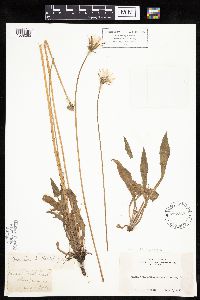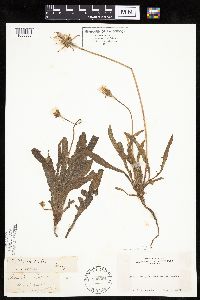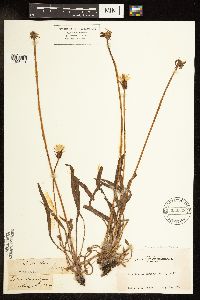Agoseris x elata
|
|
|
|
Family: Asteraceae
|
Stems 0. Leaves erect to ascending; blades usually oblanceolate, sometimes lanceolate or obovate, 15-25 cm, margins usually toothed to lobed or pinnatifid, rarely entire, lobes 2-4 pairs, lanceolate to triangular, antrorse to spreading, lobules mostly 0, faces glabrous and glaucous or sparsely villous. Peduncles ± elongating after flowering, 15-65(-90) cm in fruit, glabrate, or apically pubescent or villous, ± stipitate-glandular. Involucres obconic to campanulate, 2-4 cm in fruit. Phyllaries in 2-4 series, medially rosy purple, sometimes purple-black apically, rarely all green or purple-black spotted, faces pubescent to villous, ± stipitate-glandular; outer mostly spreading, adaxially ± villous and eglandular; inner erect, elongating after flowering. Receptacles epaleate. Florets (25-)50-150; corollas orange or yellow, tubes 8-10 mm, ligules 6-8(-12) × 1-3 mm; anthers 2-3(-5) mm. Cypselae (11-)14-20 mm, bodies ± fusiform, (6-)8-10 mm, beaks 5-10 mm, mostly equaling bodies; ribs broadly ridged, straight; pappus bristles in 2-3 series, 10-14 mm. Flowering Jun-Sep. Lowland prairies; 10-100 m; Oreg., Wash.; and montane meadows or open pine forests; 1400-2800 m; Calif., Oreg., Wash. Agoseris ×elata occurs in two geographically separated populations, which cannot be consistently distinguished morphologically: one mainly in scattered lowland prairie locations in the Puget Sound and Willamette Valley areas (the type collection came from this popula tion; no new collections have been taken from this region in over 65 years; it is likely extirpated) and another at high elevations in California, primarily in the Lake Tahoe region and southward in the Sierra Nevada. Agoseris ×elata has been and continues to be an enigmatic taxon. Perhaps no other name in the genus has been so misunderstood and misapplied. Many herbarium specimens labeled A. ×elata are in fact misidentified. Specimens of A. ×elata are not abundant in herbaria; the number of actual collections is relatively small compared to those for other Agoseris. Specimens that belong to A. ×elata represent a complex assemblage that has relatively few defining features and appears to be of hybrid origin. Most specimens appear to be intermediate between A. grandiflora and A. aurantiaca; most also appear to have characteristics of A. monticola or A. glauca var. dasycephala. The exact parentage remains unclear.
|




